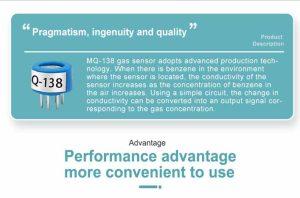-
Breathing Easy: The Impact of Gas Sensors on Indoor Air Quality
- Indoor air quality (IAQ) is a critical aspect of our daily lives, as we spend a significant amount of time indoors. Poor IAQ can lead to various health issues, including respiratory problems, allergies, and headaches. In recent years, the……
- Chat Online
-
Description
Indoor air quality (IAQ) is a critical aspect of our daily lives, as we spend a significant amount of time indoors. Poor IAQ can lead to various health issues, including respiratory problems, allergies, and headaches. In recent years, the development of gas sensors has played a crucial role in monitoring and improving indoor air quality. This article explores the impact of gas sensors on IAQ and the advancements in this technology.

Understanding Gas Sensors
Gas sensors are devices that detect the presence of various gases in the surrounding environment. They are designed to measure specific gas concentrations and provide real-time data on air quality. These sensors can detect a wide range of gases, including carbon dioxide, carbon monoxide, volatile organic compounds (VOCs), and other pollutants. By continuously monitoring the air, gas sensors help identify potential sources of indoor air pollution and enable timely interventions to improve IAQ.
Impact on Indoor Air Quality
Gas sensors have revolutionized the way we perceive and manage indoor air quality. Their impact can be observed in various settings, including residential, commercial, and industrial spaces. In homes, gas sensors provide homeowners with valuable insights into the air quality, allowing them to take proactive measures to reduce exposure to harmful pollutants. For instance, elevated levels of carbon monoxide can indicate a malfunctioning heating system, prompting immediate action to prevent carbon monoxide poisoning.
In commercial and industrial environments, gas sensors are essential for ensuring the safety and well-being of employees. By continuously monitoring for hazardous gases, these sensors help prevent workplace accidents and maintain a healthy indoor environment. Moreover, in settings such as laboratories and manufacturing facilities, gas sensors play a crucial role in compliance with safety regulations and standards.
Advancements in Gas Sensor Technology
The field of gas sensor technology has witnessed significant advancements in recent years. Traditional gas sensors were often bulky, expensive, and limited in their detection capabilities. However, with the rapid progress in nanotechnology and materials science, modern gas sensors have become more compact, affordable, and sensitive.
One notable advancement is the development of metal-oxide gas sensors, which offer high sensitivity to a wide range of gases. These sensors utilize nanomaterials to detect gas molecules at extremely low concentrations, making them ideal for IAQ monitoring. Additionally, the integration of wireless connectivity and data analytics has enabled the creation of smart gas sensor systems that can provide real-time monitoring and actionable insights.
Furthermore, the emergence of portable and wearable gas sensors has empowered individuals to monitor their personal exposure to air pollutants. These compact devices can be integrated into smartphones or wearable accessories, allowing users to track their indoor and outdoor air quality in real time. Such innovations not only raise awareness about IAQ but also enable individuals to make informed decisions to protect their health.
Challenges and Opportunities
While gas sensors have significantly improved IAQ monitoring, several challenges persist in their widespread adoption and effectiveness. Calibration and maintenance of gas sensors are critical to ensuring accurate and reliable measurements. Moreover, the diversity of indoor air pollutants poses a challenge in designing sensors that can detect a wide range of gases with high specificity.
Despite these challenges, the opportunities for gas sensor technology in enhancing IAQ are vast. The integration of gas sensors with smart building systems and IoT platforms holds the potential to create intelligent, self-regulating indoor environments. By leveraging real-time data from gas sensors, building management systems can optimize ventilation, air filtration, and energy efficiency to maintain healthy IAQ while minimizing energy consumption.
Furthermore, the application of machine learning and artificial intelligence in gas sensor data analysis can enable predictive maintenance and early detection of air quality issues. By identifying patterns and trends in gas sensor data, AI algorithms can anticipate potential IAQ problems and recommend preventive actions, thus preemptively mitigating health risks associated with poor air quality.

Conclusion
Gas sensors have become indispensable tools for monitoring and improving indoor air quality. Their ability to detect a wide range of gases and provide real-time data has transformed the way we approach IAQ management. As technology continues to advance, the integration of gas sensors with smart building systems and the use of data analytics hold promise for creating healthier indoor environments.
Breathing easy in indoor spaces is no longer just a hope but a tangible reality, thanks to the ongoing innovations in gas sensor technology. With a concerted effort to address the remaining challenges and capitalize on the opportunities, gas sensors will continue to play a pivotal role in ensuring that we breathe clean and healthy air indoors.
In conclusion, the impact of gas sensors on indoor air quality cannot be overstated. As we continue to prioritize health and well-being, the advancement of gas sensor technology will remain a crucial factor in creating safe and healthy indoor environments for all.
-
Recommend:
-
-
Gas detectors are crucial devices used in various industrie…
-
How do gas detectors ensure industrial safety?
Gas detectors play a crucial role in ensuring the safety of…
-
How Gas Sensors Help Combat Air Pollution?
Air pollution is a pressing global issue that poses signifi…
-
How can gas sensors be used in air quality monitoring?
Air pollution is a significant global concern that affects …
-
 : +86 155 8830 2704
: +86 155 8830 2704 : jxdziot@gmail.com
: jxdziot@gmail.com
